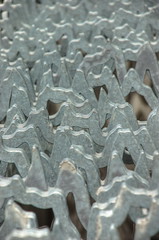Penmachine
26 May 2009
Seventh time's the charm
Photography website The Luminous Landscape has a fascinating, short essay on how photographer Art Wolfe went through a series of attempts (all shown) to get what turned out to be a great photo.
Aside from his attempts at different composition and lighting, perhaps what's most interesting is that Wolfe took enough pictures for his fisherman subjects to get bored. By the end they were no longer posing, just going on with their work, and that's when the best photo happened. The lesson: keep trying.
Labels: art, photography
23 February 2009
How to take great point-and-shoot photos
 Via Jason Kottke, here is a useful article on how to make great photos using your point-and-shoot digital camera—by learning from the great photographers who shot film decades ago with even more limited equipment.
Via Jason Kottke, here is a useful article on how to make great photos using your point-and-shoot digital camera—by learning from the great photographers who shot film decades ago with even more limited equipment.
You can only learn so much from people who frequently work in ways that are impossible for you. What if there were truly masterful photographers who worked with cameras with all the limitations of yours and more? Couldn't they be role models? Luckily, there are boatloads of them: every documentary photographer working from the 1930s to the 1980s.
The basics? Learn to compose, let black be black, use black-and-white when appropriate, photograph near windows with natural light, and take lots of pictures, then edit—pick the best shots from the many you have. If you get really good, you might regularly capture the decisive moment in single shots like Cartier-Bresson, but that will take time.
Labels: art, geekery, photography
10 February 2009
Real cutting and pasting
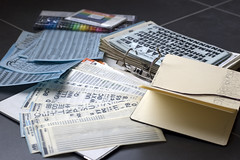 Graphic designer Michael Bierut is more than a decade older than me, but still, his article in the New York Times (via Kottke) this week felt familiar. I realized that's because, even though I've only hacked around the edges of the business of design and layout, I've been doing it for more than 30 years in some way or another.
Graphic designer Michael Bierut is more than a decade older than me, but still, his article in the New York Times (via Kottke) this week felt familiar. I realized that's because, even though I've only hacked around the edges of the business of design and layout, I've been doing it for more than 30 years in some way or another.
More importantly, I belong to what is probably the last generation to straddle the gap between pre- and post-computer design. In elementary school in the 1970s, we made student newspapers with pens on Gestetner mimeograph paper, reproduced on smeary blue-inked sheets just like our notices and test papers. (More than a decade later, I had a used hand-crank Gestetner in my basement to run off newsletters for my computer club the Apple Alliance—there's some irony, or at least foreshadowing, in that.)
By the mid-1980s I was printing out long columns of dot-matrix type to cut and paste (with actual scissors and glue) onto photocopy masters, while also using Letraset rub-on letter stencils for headlines. That was for student newspapers—but putting together our high school annual still involved typewritten text, printed photos, rubber cement, and grease pencil. The real work of typography and layout was left to the professionals we never met at the printing plant in Winnipeg. We had perhaps two or three choices of typeface.
A few years later, the Science Undergraduate Society at UBC had an IBM PC clone with Ventura Publisher, and then a Mac with PageMaker. The only laser printer available was downtown, so I took floppy disks down and paid several dollars a page to print out 8x10s, which we then lined up to assemble tabloid-style layouts on blue-lined layout sheets. I drove those down to the printer to produce some of the first issues of The 432.
By the early '90s, everything was digital until the presses rolled, and a few years after that even floppies or CD-Rs were passé in favour of email and FTP. This decade I've hardly done anything for print at all: what little design work I do is for the Web, or podcasts, or maybe a PDF file that might get printed. Maybe.
So for me, a desktop, rulers, pica scales, cut and paste, cropping, and so on represent memories of the real physical activities. My kids may do some similar things for art projects, and with their grandmother when creating cards and photo books in her crafting room in Maple Ridge, but I don't expect they ever will for publication. Why would they, when we have six Macs (and two laser printers) in the house?
Labels: art, design, ego, memories, retro, school
01 February 2009
Where you once belonged
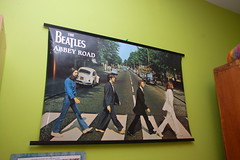 After linking to the excellent Playing The Beatles Backwards review a few days ago, I've been listening to their stuff again with a fresh ear, especially to some of the less famous tracks. And though I've been playing Beatles music in a cover band for over 20 years, they still blow me away.
After linking to the excellent Playing The Beatles Backwards review a few days ago, I've been listening to their stuff again with a fresh ear, especially to some of the less famous tracks. And though I've been playing Beatles music in a cover band for over 20 years, they still blow me away.
Think about this: those four lads recorded Rubber Soul in less than a month, releasing it near the end of 1965. Then Revolver followed eight months later. Sgt. Pepper came ten months further on. So they recorded and released not only their three best albums, but three of the best rock albums of all time, encompassing at least a dozen of the greatest songs—all in a year and a half.
Oh, and they managed to put out a few singles you might have heard of during that time too: "We Can Work It Out," "Day Tripper," "Paperback Writer," "Rain," "Yellow Submarine," "Eleanor Rigby," "Penny Lane," and "Strawberry Fields Forever." Several of them didn't even appear on the albums. They were bonus songs.
Forty years on, it's easy to forget the almost thermonuclear burst of musical creativity The Beatles offered the world. Their recording career lasted from "Love Me Do" in mid-1962 until "I Me Mine" (from Let It Be) at the very beginning of 1970, a little over seven years. There's never been anything like it, before or since.
My older daughter watches MuchMusic and has me put on Top 40 radio in the car, but given the chance, she'd rather listen to The Beatles anytime, and their posters adorn her walls. The first few notes of "I Saw Her Standing There" can still bring a crowd to their feet dancing. "A Day in the Life" can make them weepy. "Hey Jude" will get them swaying. The Beatles, who did almost everything before I was born, still make me glad for the existence of music.
Labels: art, band, family, memories, music
13 January 2009
Popeye is public domain
Slowly, some of our more familiar modern cultural icons are becoming public domain, and now Popeye is one of them.
Labels: americas, art, copyright, publicdomain
26 October 2008
Photographers and art
My family are not art collectors by any means, but over the years my wife and I have acquired some original prints by artists of varying degrees of renown—some from the artists directly. Today she dropped by Vancouver's Portobello West fashion and art market, where among other things she picked up two photos of koi from a booth set up by North Vancouver–based Jeff Maihara.
The pictures fit well with some of the other artwork we already have in our house, but we haven't figured out exactly where to put them yet. Vancouver produces some fine photographers, including our friends Alastair, Kris, and Duane. I hadn't heard of Jeff before, so it's nice to find another one.
Oh, and on a completely unrelated note, Bill in Omaha had a weird dream about me and my bandmate Mark.
Labels: art, photography, shopping, vancouver
15 July 2008
Who are those fuzzy brown rectangular monsters chasing the kitten?
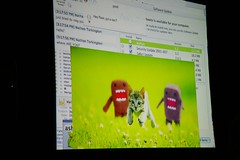 One of the classic Internet meme images is the blocky stuffed monsters chasing a tiny cat. (The associated tagline is "Every time you masturbate, God kills a kitten.") I didn't know the origins of the image, or who the monsters were, so at a low level I wondered about it—but not enough to look it up.
One of the classic Internet meme images is the blocky stuffed monsters chasing a tiny cat. (The associated tagline is "Every time you masturbate, God kills a kitten.") I didn't know the origins of the image, or who the monsters were, so at a low level I wondered about it—but not enough to look it up.
Then Tod asked, in frustration, "What IS this anyway?" Since I was already in bed with chemo side effects without the motivation to do much else, that got me rolling. It didn't take much to find out, and inevitably the best explanation was at Wikipedia:
Domo is the mascot of Japan's NHK television station, appearing in several 30 second stop-motion sketches shown as station identification during shows. [...]
[Domo-kun is] described as 'a strange creature that hatched from an egg.' Domo's favorite food is Japanese-style meat and potato stew, and he has a strong dislike for apples, due to an unexplained mystery in his DNA. Domo-kun is known to pass gas repeatedly when nervous or upset. [...]
The popularization of Domo as an internet meme and cliche outside of Japan is often attributed to a Fark thread from July 28th, 2001. The thread became popular on the then-young site, prompted in part by its serendipitous ID number of 31337. From there, Fark users began using the image and likeness of the character in various image contests and as additional, humorous banter in threads.
Alas, most images in the thread are now broken, so Google Images and Flickr to the rescue.
In other words, it's one of those semi-fluky Internet memes that no one could possibly have predicted. But the meme-launching "Domo-kuns chasing the kitten" photo has just the right combination of cute and "blurry '70s Sasquatch documentary" creepy for me that, in a way, it needs no explanation.
Labels: art, flickr, geekery, humour, meme, todmaffin, web
25 June 2008
High-definition Fairview
Today I had a meeting with the trial nurse for my upcoming resumed chemo treatments next month, followed by a series of blood tests, an appointment with my oncologist and the nurse again, then a CT scan. In between, I had some time to kill, so I had lunch at White Spot, then took time to walk around the Fairview neighbourhood and experiment some more with high dynamic range (HDR) photography.
Here are the results:
For each photo, I set my Nikon D50 camera to take three bracketed exposures: one at the default exposure the camera estimates, one two stops darker, and one two stops lighter. Then I used Photomatix Pro on my Mac to assemble them into HDR images, then tone-map them into the pictures you see. It's fun.
Labels: art, cancer, chemotherapy, hdr, photography, software, vancouver
07 April 2008
Lovely aerial night city photos from Doc Searls
Check out this beautiful set of pictures of city lights from Doc Searls. He took them while flying on a commercial jet up the U.S. East Coast:
It's a shame that we waste so much energy radiating light out into space, but it's pretty.
Labels: airport, art, canon, docsearls, environment, flickr, photography
28 January 2008
Help design this year's Northern Voice poster
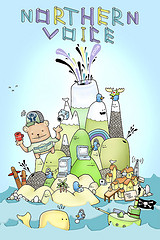 Vancouver artist Basco5 is once again designing the fabulous poster for the upcoming fourth annual Northern Voice blogging and social media conference here in town. (Last year the organizers were kind enough to give me one of Basco5's big 2007 posters, which now hangs in our bedroom.)
Vancouver artist Basco5 is once again designing the fabulous poster for the upcoming fourth annual Northern Voice blogging and social media conference here in town. (Last year the organizers were kind enough to give me one of Basco5's big 2007 posters, which now hangs in our bedroom.)
This year, Basco5 and the NV crew would like your input to help design the poster, so head on over to Flickr and leave a comment if you have ideas or suggestions.
I already like this year's tiki text/"squishy volcano" look.
Labels: art, conferences, design, flickr, northernvoice
22 November 2007
The mug
 Most mornings I make myself coffee, like many people. And like many of you, I'm sure, I have a favourite mug. It's pretty large, wide, and stable, with a big handle and a smooth rim. Running part way around the lower side is an arced ridge in the ceramic. The glaze is grey with dark speckles, and the bottom is unfinished and gritty.
Most mornings I make myself coffee, like many people. And like many of you, I'm sure, I have a favourite mug. It's pretty large, wide, and stable, with a big handle and a smooth rim. Running part way around the lower side is an arced ridge in the ceramic. The glaze is grey with dark speckles, and the bottom is unfinished and gritty.
My father-in-law made it. He's been making pottery as a hobby for decades, and from time to time we get the chance to rummage through his stockpile and pick pieces we particularly like. I'm not sure what it is about this particular mug that appeals to me, but it makes the coffee taste better, as well as hard to spill.
It's also unique, as handmade pottery must be. He has crafted some others like it, but none identical. If it ever goes missing or breaks, there are others we own, both handmade and commercial, that will do the job. But not quite the same.
Do you have a favourite mug? Why that one?
15 November 2007
All acrylic deliciousness
I love Chris Reccardi's super-retro prints and paintings (via Music Thing).
Oh, and Lala from Tiki Bar TV is going to sell a lot of these calendars.
03 June 2007
There's public in that thar public domain
 If a piece of art or other work is old enough, it becomes public domain, like Da Vinci's "Mona Lisa." That means anyone can reproduce it at no charge—the original creator (who is long dead) no longer holds copyright to it. Nobody owns it anymore, and it is free for anybody to use as they wish, including doing funny things with it.
If a piece of art or other work is old enough, it becomes public domain, like Da Vinci's "Mona Lisa." That means anyone can reproduce it at no charge—the original creator (who is long dead) no longer holds copyright to it. Nobody owns it anymore, and it is free for anybody to use as they wish, including doing funny things with it.
In Canada, the works of an author generally become public domain 50 years after the end of the year in which he or she dies (sooner, apparently, for music recordings—does that mean early Elvis recordings are free for the taking here now?). So, for instance, the paintings of Emily Carr, who died in 1945, became public domain over a decade ago.
Interestingly, Michael Geist points out that many musems and galleries attempt to assert copyright over reproductions of public domain works, including Emily Carr paintings, and charge significant fees to make those reproductions.
But, he argues, court cases are beginning to establish that "while museums are understandably searching for revenue streams, doing so on the basis of misleading copyright claims is not the way to do it." We all need to remember copyright law, like patent and trademark law, is not like a law of physics; rather it is a human invention designed to foster creativity by balancing the rights of creators and the general public.
You'd never know it the way some copyright maniacs behave these days, but it's true.
Labels: art, copyright, davinci, emilycarr, fairuse, monalisa, piracy, publicdomain




